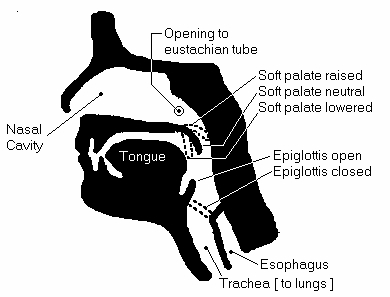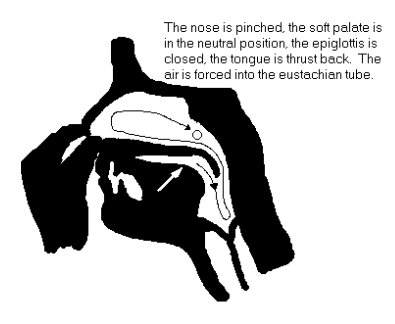It pains me to debate with such a respected member but I may have found the source of our different interpretations. I think is is fair to say that most divers in English speaking countries think of the word "nostrils" as the external nostrils like the image below:
This is news to me but there are also "integral nostrils" which may also be called:
- Internal Nares
- Posterior Nostrils
- Posterior Nares
- Posterior Nasal Aperture
View attachment 734210
Note the image below with particular attention to the names in red rectangles.
View attachment 734209
The Frenzel maneuver is performed by raising the soft palate to block the internal nares (nostrils) and the oral cavity. This creates a closed cavity labeled nasopharynx in the above illustration. Note that the eustachian tube opening is inside this cavity. Raising the soft pallet further causes the gas in this cavity to slightly compress and force gas into the eustachian tube to equalize the inner ear.
View attachment 734219
Apparently there are a small number of people who cannot block their internal nares with their soft palate so must resort to manually pinching their external nares/nostrils. Unfortunately this is much less effective because the higher volume of the nasopharynx plus the nasal cavity results in lower pressure because of the limited movement of the soft palate. Of course there is no reason for Scuba diver with this condition to use Frenzel instead of just using the Valsalva maneuver.
The reason that freedivers use the Frenzel maneuver instead of the Valsalva maneuver is because the lungs are compressed enough at around the 3 ATA/20m/66' that they can no longer generate enough pressure to equalize. The Frenzel maneuver is comparatively depth independent. There is a misnomer that freedivers swallow air performing the Frenzel maneuver but that is not the optimal technique.
I learned the Frenzel maneuver as a hands-free equalizing method from
Kirk Krack in
Performance Freediving International's Intermediate Freediving class (now part of
TDI). Optimally, competitive apnea divers want to be more streamlined and use the absolute minimum energy to equalize.
I think it is fair to say that Hermann Frenzel intended the maneuver to be hands-free so that pilots in unpressurized cabins could use both hands to fly the plane and manage weapons.
For other readers
Valsalva maneuver blocks the exterior nostrils, or nares in the above image, while the lungs (diaphragm and chest mussels) raise the pressure in the oral and nasal cavities to force air into the eustachian tubes. It is most commonly done by manually pinching the external nostrils closed but can also be done by forcing something, like an oval mask without a nose pocket, up against the external nostril openings.
The Valsalva maneuver (pinch your hose and blow) is the most common method in Scuba diving because it is so easy to teach and can produce a little higher pressure in most people than the Frenzel maneuver.
Related note
View attachment 734231A very common question is how do divers in heavy gear equalize their ears (using the Valsalva maneuver)? This is a little unsanitary but they raises their shoulders so their upper lip can press against the rim/ledge of the bayonet flange and press up to block their exterior nostrils.
Here are some other references on equalizing:
Barotrauma: The Ins and Outs of the Pops and Cracks by
@Duke Dive Medicine
Ear Problems in Scuba Diving by
@doctormike
This all very interesting.
Some background first.
Here in Italy we have developed an equalization technique where pressure is generated by closing the soft palate and raising it, but also pinching the external nostril with fingers, like in Valsalva. This method is named Marcante-Odaglia and was first published in Italian medical journals around 1950.

it.wikipedia.org
Years later, when the method was proposed internationally within the CMAS community, we were told that the method was basically the same as Frenzel.
Only difference is that Frenzel is practiced with the mouth closed, not breathing, whilst Marcante-Odaglia was developed for scuba divers using the ARO (CC pure oxygen rebreather) so the device cannot be removed easily from mouth, which stays open, and you can breath while equalising, as mouth and epiglottis are left open.
But in both cases the noise is pinched and the soft palate raised.
Most web sites describing Frenzel also say to pinch nostrils:

en.wikipedia.org
For most people raising (closing) the soft palate is easy (for example when filling a rubber balloon with the mouth).
But such a valve is BELOW the Eustachian tubes (as also shown in your figures).
So you need to trap air inside the nasal cavity for exerting pressure inside it, closing also the nostrils.
I suppose from what you write that there should be another valve closer to the nostrils, so that air can be trapped between the two valves (soft palate and these "internal nostrils").
It is a fascinating theory, and I do not have enough anatomical knowledge for confirming or rebutting it.
What I can say is that in most freediving courses Frenzel is taught to be practiced with the mouth closed and pinching the external nostrils.
Here in Italy, good instructors also know of the Marcante-Odaglia method and of his small difference between it and Frenzel (mouth open vs mouth closed), but, as said, always pinching the nostrils.
Outside Italy Marcante-Odaglia is unknown and most instructors only teach the crap Valsalva method.
It would be interesting here the opinion of some ENT.
And, from an historical point of view, also to find the original writings of Frenzel, which should not be classified anymore.
I always had the impression that, while diving on a Stuka, a pilot was not easily pinching his nose.
So I agree with you that initially the Frenzel method was probably hands free, and possibly much more similar to BTV (which was invented, or, better, discovered later, in the eighties, in France - but I was slready using BTV dince my childhood, in the sixties, making me eondering why most other free divets were pinching their nose, as I wasn't needing to do it for equalising).
So perhaps all the history of equalization methods should be rewritten.
I hope that others more aknowledged than me can contribute.
This topic of hands-free equalization is really nice!








